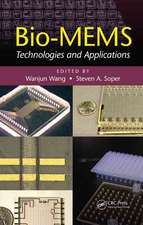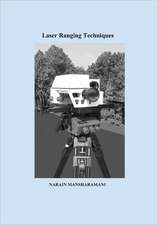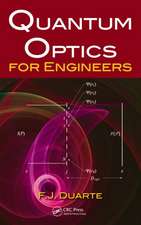Biomimetics in Photonics: Series in Optics and Optoelectronics
Editat de Olaf Karthausen Limba Engleză Hardback – 26 oct 2012
Exploring a biomimetic approach to developing photonic devices and structures, Biomimetics in Photonics discusses not only the role of and results of biomimicry in engineering, but also the true understanding of natural processes and the application of these techniques to established technologies.
Featured Topics
- Photonic structures in flowers, leaves and fruits and inorganic structures produced in aquatic environment by diatoms, sponges, and shells
- Mechanisms for biomineralization and how natural structures can be synthetically modified or even used as templates for artificial photonic materials
- Biological photonic structures in beetles and butterflies and their bio-inspired applications, including anti-reflecting surfaces, iridescent viruses, light reflection, metallic effects, and infrared sensors
| Toate formatele și edițiile | Preț | Express |
|---|---|---|
| Paperback (1) | 312.43 lei 6-8 săpt. | |
| CRC Press – 30 iun 2020 | 312.43 lei 6-8 săpt. | |
| Hardback (1) | 1061.06 lei 6-8 săpt. | |
| CRC Press – 26 oct 2012 | 1061.06 lei 6-8 săpt. |
Din seria Series in Optics and Optoelectronics
-
 Preț: 363.43 lei
Preț: 363.43 lei -
 Preț: 360.61 lei
Preț: 360.61 lei - 18%
 Preț: 1067.35 lei
Preț: 1067.35 lei - 9%
 Preț: 1249.34 lei
Preț: 1249.34 lei -
 Preț: 364.86 lei
Preț: 364.86 lei - 18%
 Preț: 1272.54 lei
Preț: 1272.54 lei - 18%
 Preț: 1391.72 lei
Preț: 1391.72 lei - 23%
 Preț: 427.84 lei
Preț: 427.84 lei - 12%
 Preț: 312.43 lei
Preț: 312.43 lei - 25%
 Preț: 999.98 lei
Preț: 999.98 lei - 27%
 Preț: 888.62 lei
Preț: 888.62 lei - 9%
 Preț: 335.20 lei
Preț: 335.20 lei - 18%
 Preț: 1277.45 lei
Preț: 1277.45 lei - 15%
 Preț: 489.26 lei
Preț: 489.26 lei - 18%
 Preț: 1938.64 lei
Preț: 1938.64 lei -
 Preț: 436.14 lei
Preț: 436.14 lei -
 Preț: 430.43 lei
Preț: 430.43 lei - 27%
 Preț: 1212.67 lei
Preț: 1212.67 lei -
 Preț: 453.88 lei
Preț: 453.88 lei - 29%
 Preț: 1355.27 lei
Preț: 1355.27 lei - 12%
 Preț: 312.43 lei
Preț: 312.43 lei - 18%
 Preț: 1811.96 lei
Preț: 1811.96 lei - 28%
 Preț: 988.95 lei
Preț: 988.95 lei - 28%
 Preț: 987.33 lei
Preț: 987.33 lei - 9%
 Preț: 336.42 lei
Preț: 336.42 lei -
 Preț: 433.30 lei
Preț: 433.30 lei - 18%
 Preț: 1000.27 lei
Preț: 1000.27 lei - 18%
 Preț: 273.89 lei
Preț: 273.89 lei -
 Preț: 434.63 lei
Preț: 434.63 lei -
 Preț: 436.14 lei
Preț: 436.14 lei - 18%
 Preț: 812.95 lei
Preț: 812.95 lei - 28%
 Preț: 992.94 lei
Preț: 992.94 lei - 9%
 Preț: 975.99 lei
Preț: 975.99 lei - 12%
 Preț: 312.43 lei
Preț: 312.43 lei -
 Preț: 440.61 lei
Preț: 440.61 lei -
 Preț: 430.80 lei
Preț: 430.80 lei - 18%
 Preț: 3170.19 lei
Preț: 3170.19 lei - 20%
 Preț: 948.28 lei
Preț: 948.28 lei -
 Preț: 431.35 lei
Preț: 431.35 lei - 14%
 Preț: 315.37 lei
Preț: 315.37 lei
Preț: 1061.06 lei
Preț vechi: 1293.97 lei
-18% Nou
Puncte Express: 1592
Preț estimativ în valută:
203.03€ • 212.55$ • 167.100£
203.03€ • 212.55$ • 167.100£
Carte tipărită la comandă
Livrare economică 05-19 aprilie
Preluare comenzi: 021 569.72.76
Specificații
ISBN-13: 9781439877463
ISBN-10: 1439877467
Pagini: 290
Ilustrații: 154 b/w images, 32 color images, 4 tables and Approx. 70 equations
Dimensiuni: 156 x 234 x 23 mm
Greutate: 0.64 kg
Ediția:New.
Editura: CRC Press
Colecția CRC Press
Seria Series in Optics and Optoelectronics
ISBN-10: 1439877467
Pagini: 290
Ilustrații: 154 b/w images, 32 color images, 4 tables and Approx. 70 equations
Dimensiuni: 156 x 234 x 23 mm
Greutate: 0.64 kg
Ediția:New.
Editura: CRC Press
Colecția CRC Press
Seria Series in Optics and Optoelectronics
Public țintă
Researchers and graduate students in photonics, materials science, and biophysics.Cuprins
Photonic Structures in Plants. Biomineralization and Photonics. Biometrics of Optical Nanostructures. Photomechanic IR Receptors in Pyrophilous Beetles and Bugs. Toward Industrial Production of Biomimetic Photonic Structures. A Night Vision Algorithm Inspired by the Visual System of a Nocturnal Bee. Modeling and FDTD Calculations.
Recenzii
"… interesting and illuminating … a useful introduction to the field of biomimetics for photonic applications."
—MRS Bulletin, July 2014
"… provides new insights into biomimetic photonics. … The reader will find a careful discussion of a night-vision algorithm inspired by the visual system of a nocturnal bee, and a presentation of bio-inspired antireflection coatings."
—Christian Brosseau, Université de Bretagne Occidentale in Brest, France, and a Fellow of OSA
—MRS Bulletin, July 2014
"… provides new insights into biomimetic photonics. … The reader will find a careful discussion of a night-vision algorithm inspired by the visual system of a nocturnal bee, and a presentation of bio-inspired antireflection coatings."
—Christian Brosseau, Université de Bretagne Occidentale in Brest, France, and a Fellow of OSA
Descriere
This book explores a biomimetic approach for developing and improving photonic devices and structures. Leaders in the field discuss not only the mimicking of natural structures and solutions to engineering problems, but also the true understanding of natural processes and the application of these techniques to established technologies. Suitable for researchers and graduate students, the book does more than describe how to extract good design from nature—it highlights natural design techniques in context, allowing for a more complete modeling picture.














